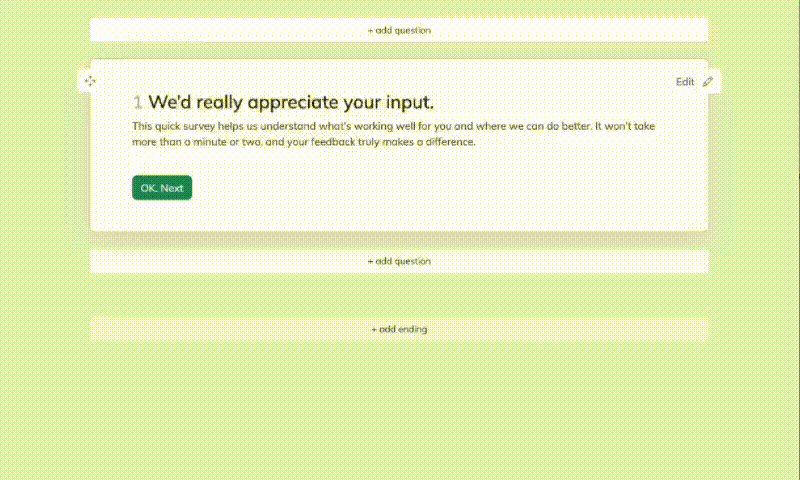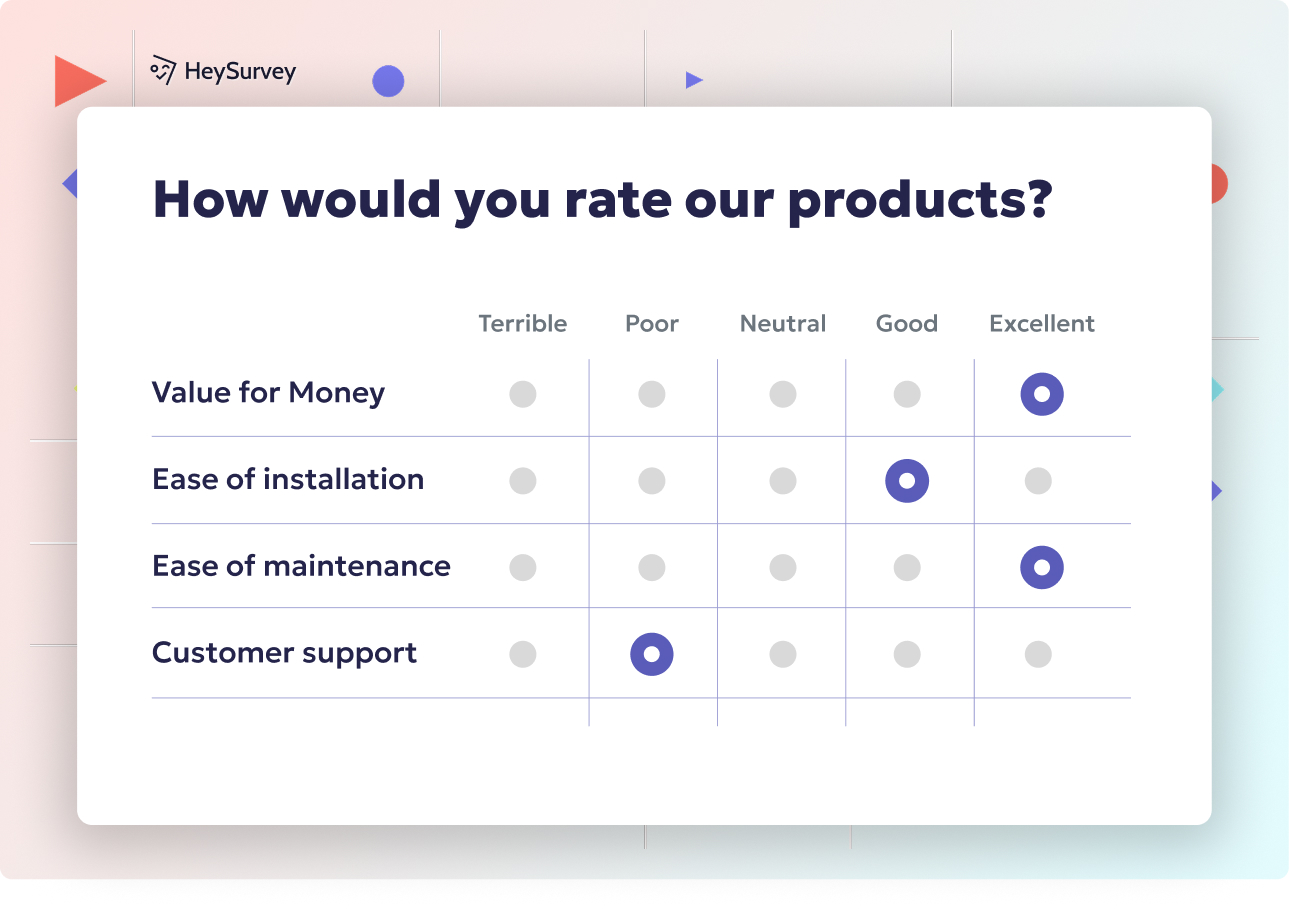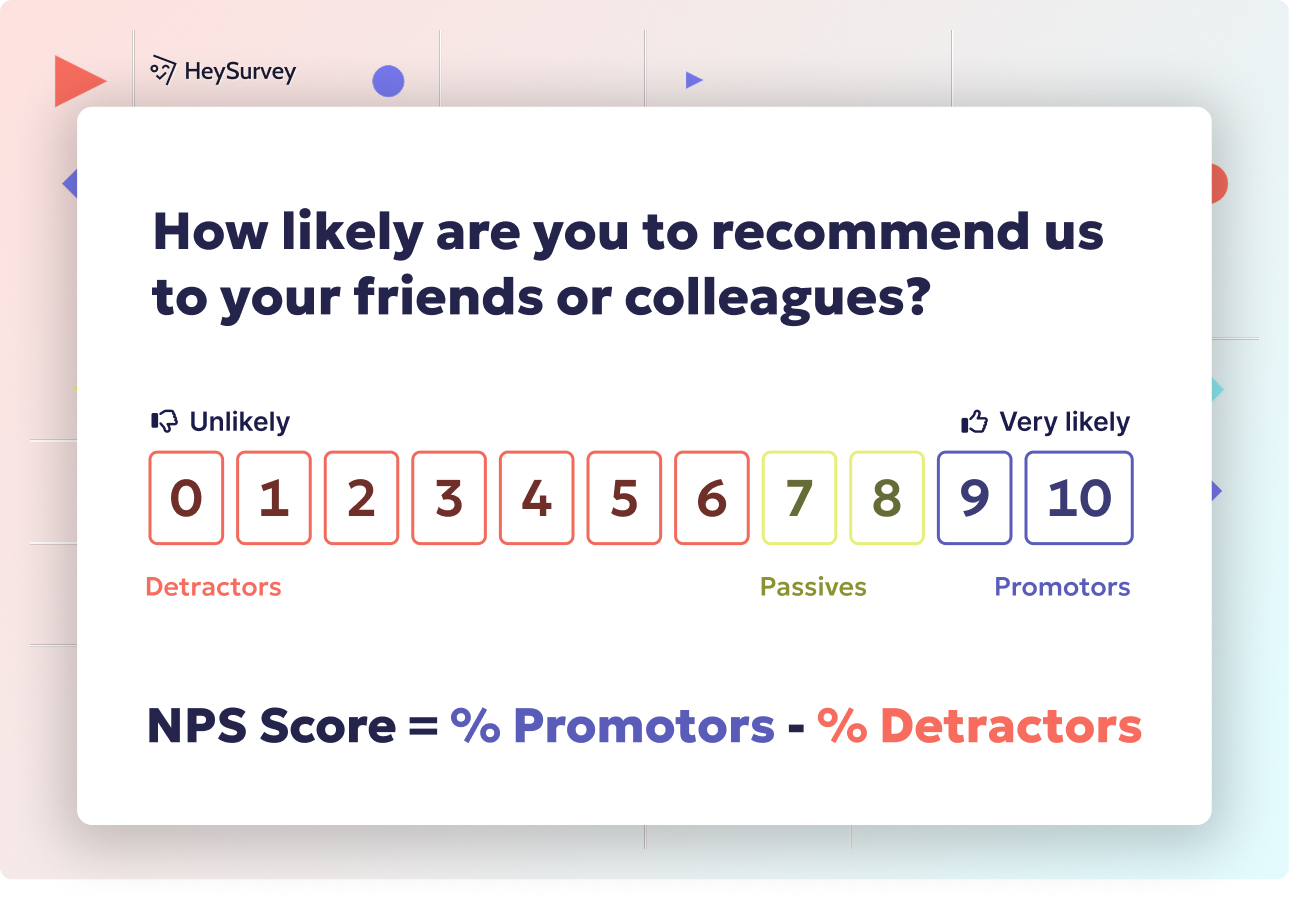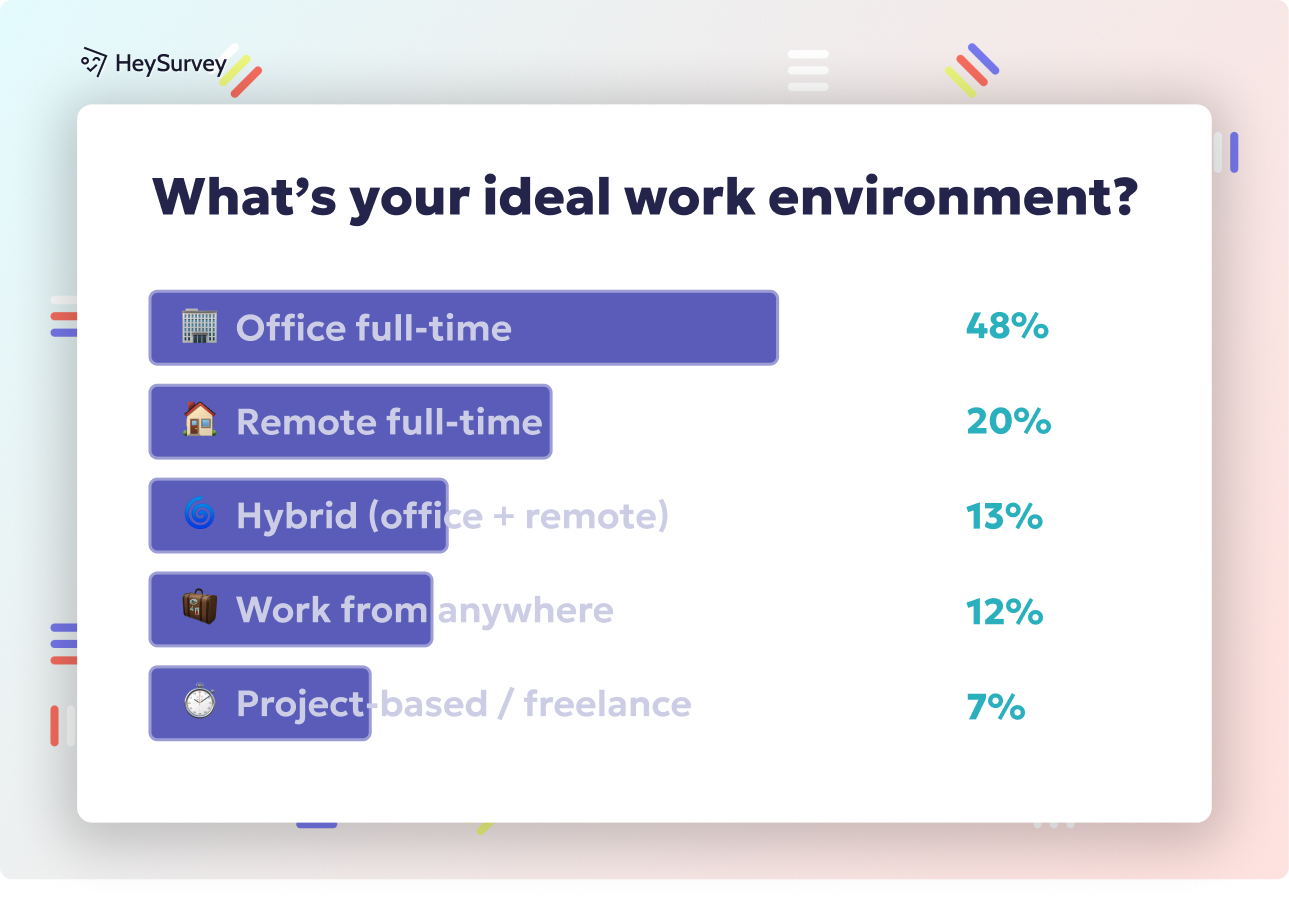32 Teacher Survey Questions: Types, Examples & Tips
Discover 45+ teacher survey questions with examples and tips to improve job satisfaction, PD, resources, and more for effective school growth.
Teacher surveys are the unsung hero of school improvement—seriously! When used at just the right moments, they can shift the entire mood of your campus, fix teacher burnout before it bubbles over, and raise instructional quality faster than you can say “professional development.” Surveys make school leaders look like mind readers, getting vital feedback before big changes or to take a regular pulse on the mood in the teachers’ lounge. Lucky for you, this guide is loaded with powerful survey question templates, smart examples, and plenty of insider tips to help you collect honest feedback, boost your response rates, and actually make sense of the data. Stay with us—your next game-changing staff survey is about to write itself!
Teacher Job Satisfaction Survey
Why and When to Use This Survey
Measuring job satisfaction isn’t just good manners—it’s school survival. When teachers feel ignored or undervalued, it’s only a matter of time before their enthusiasm dips or they start scrolling job boards on their lunch break. A well-timed job satisfaction survey helps you catch morale issues before they turn into full-blown turnover headaches.
Deploy this survey at least once a year, or after you drop a major new policy. Don’t wait until annual exit interviews—then it’s too late! By checking in regularly, you’ll spot trends, identify problem areas, and see what’s actually going well for your hard-working team. If you’re navigating big changes, like new curriculum or leadership, send the survey a few weeks in.
Top reasons to survey for job satisfaction include:
- Pinpointing what’s driving retention and what’s pushing teachers out
- Spotting hidden stressors in the work culture
- Opening dialogue to improve the staff experience
Frequency is everything: annual surveys set a useful baseline, but post-initiative check-ins let you see the real impact of your decisions. Surprise—you might be doing something right!
5 Sample Questions
On a scale of 1–10, how valued do you feel by school leadership?
How satisfied are you with the support you receive from administration?
What aspect of your teaching job gives you the most fulfillment right now?
How likely are you to recommend this school as a workplace to a friend?
What is one change that would make your daily work experience significantly better?
Only 15% of public K-12 teachers are extremely or very satisfied with their salary, highlighting widespread dissatisfaction with compensation. (pewresearch.org)

Here’s how to create your teacher survey quickly and easily with HeySurvey. Ready to get started? Just follow these 3 simple steps—and then check out the bonus tips to make your survey truly shine!
Step 1: Create a New Survey
- Head to HeySurvey and click Create New Survey.
- Choose your preferred starting point: pick an empty sheet to build from scratch, select a pre-built teacher survey template (perfect for faster setup), or try typing in questions directly for auto-formatting.
- Give your survey an internal name so you can identify it later—something like “Teacher Job Satisfaction Fall 2024” works well.
Step 2: Add Questions
- Use the Add Question button to start filling your survey with the teacher questions you want to ask.
- Select the question type that fits best: multiple choice for satisfaction scales, text input for open feedback, or scales for rating questions.
- Customize each question’s text, add descriptions if you want, and set any required fields to make sure key answers come through.
- For choice questions, you can let teachers pick multiple answers or just one. You can even add an “Other” option for more honest input.
Step 3: Publish Survey
- When you’ve added all your questions, click Preview to test how your survey looks and flows on desktop and mobile.
- Satisfied? Hit the Publish button. Note: you’ll need a free HeySurvey account to publish and view responses.
- Grab the shareable link or embed code, then send it out to your teachers!
Bonus Step 4: Apply Branding
- Open the Branding panel to upload your school’s logo and colors. This makes your survey instantly recognizable and professional-looking.
- Customize fonts, background, and question card styles in the Designer Sidebar to match your school's style and keep teachers engaged visually.
Bonus Step 5: Define Survey Settings
- Set your survey’s start and end dates so it’s live only during your preferred feedback window.
- Limit the total number of responses if needed.
- Use the Redirect URL feature to guide teachers to a thank-you page or resource after completion.
- Decide whether respondents can view results afterward—perfect for transparency with multiple-choice or rating questions.
Bonus Step 6: Skip Into Branches
- Use HeySurvey’s branching features to create smart paths through your survey.
- For example, if a teacher answers “No” to feeling supported, branch them to a question asking what support is missing. If they say “Yes,” skip that question entirely.
- Tailored paths keep the survey relevant and concise, reducing fatigue and gathering richer insights.
You’re all set to create, customize, and launch your teacher survey with HeySurvey! Click the button below to start defining your questions right now.
Professional Development Needs Survey
Why and When to Use This Survey
Ever been to a professional development that felt designed for another planet? You’re not alone. That’s why a focused PD needs survey isn’t just helpful—it’s a budget lifesaver. By mapping actual classroom challenges to PD topics, you maximize every training dollar and make the learning feel truly relevant.
This survey belongs on the calendar just before planning your next PD cycle, whether you’re prepping the summer workshops or applying for that juicy teaching grant. If your school’s rolling out new standards or curriculum, ask teachers what they need before picking your trainers or buying that big pile of books.
Key reasons to prioritize PD needs surveys include:
- Aligning training with current (and future) instructional gaps
- Unearthing teachers’ secret strengths to tap as in-house mentors
- Avoiding “development fatigue” by cutting out irrelevant sessions
Timing is a trick: surprise your team by asking for their input before you start hunting down speakers or spending precious school cash.
5 Sample Questions
Which instructional areas do you feel least prepared to address this year?
What’s one professional skill you want to strengthen over the next semester?
Do you prefer traditional workshops, online modules, or peer coaching for your professional learning?
How often would you like opportunities for professional development?
Name a recent training that actually made a difference in your classroom practice.
Conducting professional development needs surveys enables schools to align training with teachers' actual classroom challenges, enhancing the relevance and effectiveness of professional learning. (alchemer.com)
Classroom Resources & Support Survey
Why and When to Use This Survey
Nothing begs for a survey quite like running out of construction paper or realizing your classroom reading sets are from 1997. A resources and support survey shines a light on the invisible gaps—missing supplies, stretched staffing, and broken tech—that make teaching feel impossible, some days.
Survey your teachers at least every quarter, or right after rolling out new curriculum or tech. This keeps your resource requests grounded in real-time needs instead of best guesses. And when budgets are tight, every data point helps your case for new funding.
Smart reasons to run this survey regularly:
- Catching small shortages before they become big crises
- Guiding supply orders and support staff assignments with actual teacher feedback
- Making the case for new purchases (with impressive charts for the next board meeting)
Never guess about resources when you can ask for specifics. Teachers usually know exactly what’s missing!
5 Sample Questions
What classroom supplies are you currently running low on?
Do you have adequate access to instructional technology for your teaching needs?
Which resources (books, science kits, manipulatives) do you wish were more available?
Are there staffing shortages or support needs impacting your students’ learning?
What one resource would make the biggest improvement in your day-to-day teaching?
Teacher-Student Relationship & Classroom Climate Survey
Why and When to Use This Survey
You can’t buy good vibes, but you can measure them. The quality of teacher-student relationships and classroom climate sets the stage for everything from student engagement to behavior management. When teachers have strong connections with their students, the classroom feels safer, happier, and much more productive.
Send this survey smack in the middle of each semester. That way, you’ve got time to step in, run an intervention, or identify a rising classroom star before final grades are on the line. Timing matters—if you wait until summer, reflection fizzles and action is delayed.
Why invest in this pulse-check?
- Early detection of relationship breakdowns before they affect achievement
- Identifying classrooms (or whole grades) with positive climate as a blueprint for others
- Uncovering barriers to student engagement and strategies that work
Think of it as your classroom barometer—reading the social weather and helping everyone dress accordingly.
5 Sample Questions
How would you rate the overall level of respect between students and teachers in your class?
What strategies have helped you build connections with challenging students?
Are there any factors making it difficult to create a positive classroom climate?
How often do you feel your students are engaged and motivated to learn?
What supports do you need to strengthen relationships and classroom community?
Positive teacher-student relationships are associated with increased student motivation, better academic performance, and improved mental health outcomes. (nces.ed.gov)
Technology Integration & Ed-Tech Usage Survey
Why and When to Use This Survey
Ever wondered if your stack of dusty tablets could spark more than a game of digital solitaire? A tech integration survey helps you figure out what’s really working, what’s gathering dust, and where teachers need more guidance or support. This info steers your next round of device purchases, helps you nail down key training areas, and pushes your digital equity goals forward.
Distribute this survey right after rolling out new technology, and again after those pilot programs end. You’ll catch problems early (and maybe even brag about successes to your tech committee).
Main reasons to check in on tech usage:
- Pinpointing what tools are most used (and which ones deserve early retirement)
- Planning follow-up trainings with laser focus
- Revealing barriers to access or digital fluency across grade levels
Don’t be shy—ask teachers to name and shame the tech goblins that block their progress.
5 Sample Questions
Which digital tools or platforms do you use most frequently in your classroom?
Are there any barriers preventing you from fully utilizing classroom technology?
How confident do you feel integrating technology into lessons?
What type of tech-focused professional development do you find most helpful?
What devices, software, or support would improve technology integration for you and your students?
Teacher-Parent Communication Survey
Why and When to Use This Survey
If you want student success, you can't forget about the home team. Strong communication between teachers and parents is the secret sauce for academic progress and positive school culture. A focused survey reveals what’s working, where messages are lost in translation, and how schools can help teachers build better home–school partnerships.
Send out this survey mid-year and again at the end. This timing gives you a sense of baseline communication, lets you tweak your approach, and checks whether your outreach or new platforms are actually making an impact.
Here’s why it’s a must-do task:
- Strengthens trust between families and teachers
- Highlights gaps in communication tools or processes
- Inspires new ideas for meaningful engagement
Remember—parents want to help, but they need teachers to meet them halfway.
5 Sample Questions
How often do you communicate with parents/guardians about student progress?
Which communication methods (email, phone, apps) work best for your classroom?
What challenges do you face when reaching out to families?
How can the school better support your efforts to engage parents/guardians?
Share an example of a communication strategy that helped resolve a student issue effectively.
Teacher Well-Being & Work–Life Balance Survey
Why and When to Use This Survey
Teacher well-being isn’t just about yoga mats in the staff room. Real insight into how your staff is coping—mentally and emotionally—can preempt everything from absenteeism to burnout. With clear survey data, you can track stress trends over time and make changes that actually keep teachers happily coming back each day.
Go for anonymous check-ins every quarter. Frequent, low-stakes surveys encourage honesty and help you spot trouble spots before they're out of control. Use these results to inform wellness initiatives, mental health supports, or even simple schedule tweaks during peak stress seasons.
Reasons to keep your finger on the well-being pulse:
- Lower burnout and turnover (goodbye revolving door of substitute teachers)
- Higher staff morale and more positive attitudes across campus
- Sharp reduction in chronic absenteeism linked to stress
Don’t just preach self-care—show you mean it by making well-being data part of your regular review and planning.
5 Sample Questions
How would you rate your current work–life balance on a scale of 1–10?
What factors most contribute to your stress at work?
How comfortable do you feel discussing well-being concerns with school leadership?
Which wellness resources or supports would make the most difference in your daily life?
What’s one small change that would help you feel more balanced or less stressed?
School Leadership & Administration Feedback Survey
Why and When to Use This Survey
If you want teachers to back your policies, first, just ask them how it’s going! An open feedback survey about school leadership and administration doesn’t just identify what needs to improve—it builds trust by showing you’re genuinely listening.
Break out this survey after introducing major school policies, wrapping up accreditation reviews, or bringing in new leaders. The timing is crucial for catching fresh reactions and using their insight to shape next steps. Don’t forget about the follow-up: teachers want to see that their voices sparked actual change.
Here’s why school leaders crave honest feedback:
- Informs better, more inclusive policy making
- Uncovers hidden issues before they sink your next big initiative
- Cultivates transparency and trust, especially during transitions
Build a feedback loop, and everyone becomes smarter, faster—no crystal ball required.
5 Sample Questions
Do you feel leadership effectively communicates important decisions and changes?
How responsive is administration to staff concerns and feedback?
Are there policies or practices you feel need review or revision?
What traits or actions do you most appreciate in current school leadership?
Share one suggestion that could improve the effectiveness of school administration.
Dos and Don’ts: Best Practices for Crafting Effective Teacher Surveys
Writing a great teacher survey is part science, part art, and part biting your tongue. There are a few golden rules to get plenty of useful answers without overwhelming your staff or collecting data that’s about as reliable as a hallway rumor.
Dos
Keep surveys short and purposeful. Respect teachers’ time by focusing on just what you need to know.
Guarantee anonymity. The more secure teachers feel, the more honest their answers will be.
Use neutral, non-leading wording. Make your questions opinion-free to encourage authentic feedback.
Optimize for mobile devices. Many teachers will answer surveys on the fly between classes or on lunch duty.
Always follow up—thank participants and share what you learned. This builds trust and boosts participation next time.
Don’ts
Don’t use loaded or leading questions. Nobody likes being steered toward a “right” answer.
Don’t launch surveys too frequently. Survey fatigue is real—save your asks for when they really matter.
Don’t ignore results. Failing to act on feedback is the quickest way to make future surveys pointless.
Wrap each survey effort in communication and empathy. Announce why you’re collecting data, share the outcomes, and be transparent about your next steps.
In summary, well-crafted teacher surveys are your secret weapon for school improvement. They elevate campus climate, spark innovation, and keep your best teachers coming back year after year. Listen actively, act on what you learn, and keep your community in the loop. Your teachers—and your students—will thank you.
Related Teacher Survey Surveys

32 Teacher Perception Survey Questions for School Improvement
Explore 30 insightful teacher perception survey questions, covering school climate, PD needs, lea...

29 Survey Questions for Teachers to Boost Success
Explore 25+ insightful survey questions for teachers to boost engagement, professional growth, an...

32 Survey Teacher Evaluation Questions for Effective Feedback
Discover 25+ survey teacher evaluation questions with sample items and expert tips for effective ...


